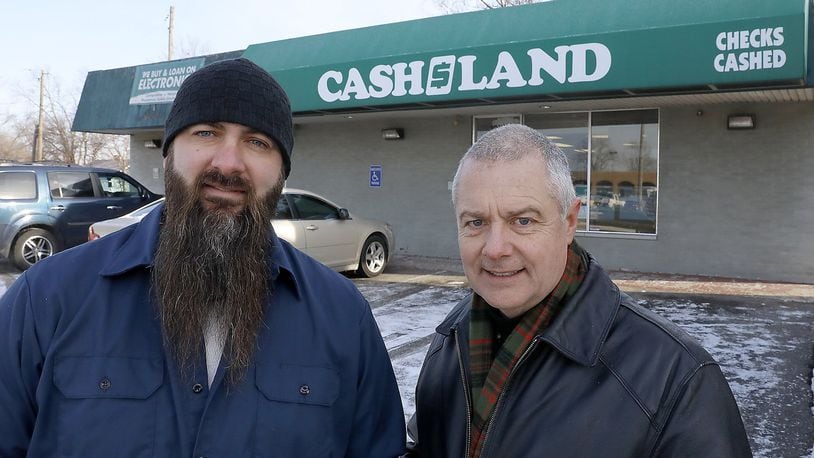RELATED: Report details payday lending ‘abuses’
They’ve team up with Springfield Rev. Carl Ruby and others to push for what they called sensible payday loan reforms to ensure a fair marketplace and save Ohioans an estimated $75 million annually, according to Pew Charitable Trusts.
But industry representatives believe the proposed changes won’t work. Ohio has about 650 storefronts in the state’s payday loan industry.
“Our businesses can’t operate under that kind of model,” said Pat Crowley, a spokesman for the Ohio Consumer Lenders Association.
Seven in 10 who use payday loan services report that the money is used to cover normal household expenses, Crowley said.
“Our services help people meet their bills, buy Christmas gifts, pay doctors bills, buy groceries — everyday things that people need to survive,” Crowley said. “Where do people turn if this kind of service is taken away? So we oppose any legislation that prevents them for taking advantage of these services.”
Ohioans are pay the highest interest rates in the nation on short-term payday loans — an average annual percentage rate of 591 percent, according to a report released this week by Pew.
But Crowley said short-term lenders don’t charge interest rates.
“Interest rates are meant to be charged on long-term loans,” he said. “That is not what we offer. Our loans are short-term. What we charge is a fee, and the customers understand that and it is very clear when they come in what the fees are.”
Payday customers are charged an estimated $145 million per year in fees, according to Pew.
READ MORE: Churches: Payday loans hurting Springfield
“Unfortunately, many payday lenders are geared toward taking advantage of households that are living paycheck-to-paycheck,” Ashford said. “For too many families, this makes it impossible to pay off the 400-percent loans, and as a result Ohioans are living behind the financial eight ball for a long time. We hope to change that.”
Ruby, the senior pastor at Central Christian Church in Springfield, has organized a local group of community and faith leaders to fight against payday loan practices, including holding a community forum earlier this year.
The short-term lending industry preys on the working poor, he said.
“These are responsible, hard-working people who are living somewhere at or near the line of poverty, people trying very hard to make ends meet,” Ruby said. “These short-term loan stores promote themselves as places to help people in times of financial crisis, but they actually make the majority of their profits by drawing people into a deeper and longer crisis of debt.”
The local coalition of faith and community leaders started about three months ago with a meeting with state Sen. Bob Hackett, R-London, and state Rep. Kyle Koehler, R-Springfield. Ruby got involved because he sees it as a moral issue and the toll it’s taking in the Springfield community.
“You don’t have to be a faith leader to be angered by what these places are doing to our communities,” Ruby said. “Any person of conscience should be alarmed and appalled.”
Crowley, of the Ohio Consumer Lenders Association, knows well the criticism of the industry.
“We hear the criticism all the time, but we don’t ever hear the solutions to these problems,” he said. “This is a vital service or people wouldn’t be using us.
Eliminating payday lenders isn’t the goal of the new bipartisan group.
“I’m not for taking away access to emergency loans, but I am for regulating their most egregious and destructive practices,” said Ruby.
Anielski and Ashford are looking Colorado as a model for the legislation they plan to propose in early 2017.
Interest rates there are capped at 4 percent, versus 38 percent prior to the 2010 reform. Borrowers spent 42 percent less and have saved more than $40 million annually since the changes. Defaults per year have dropped 23 percent.
“Reforms we are looking at would still give these consumers wide access to credit, but set rates and payback periods that are fair for borrowers and viable for lenders,” said Anielski in a statement.
Nick Bourke, who is in charge of the Pew Charitable Trusts small dollar lending project, has been working on this issue for six years. Ohio changed its payday lending laws in 2008, but Bourke said the businesses found a loophole.
“I have taken part in a lot of productive conversations with of a lot of legislators on both sides of the aisle in Ohio, and there is a lot of support for reform,” he said. “We’ll just have to wait and see how soon things can happen.”
Jan Jones, a housing specialist and credit counselor at Neighborhood Housing Project of Greater Springfield, has seen firsthand the damage the payday loan debt cycle can do. She had one client who had a decent retirement income and got involved with short-term lending. Her repayment was $800 per month.
“She came in because she needed some home repairs done and because of payday lending, she couldn’t get the leak in her roof fixed,” Jones said. “It seems so easy — you just go and borrow the money, pay it back and be done with it — but it becomes a vicious cycle. It would be cheaper to go to a loan shark.”
Unmatched coverage
The Springfield News-Sun digs into important stories that affect jobs and the economy in Clark and Champaign counties, including recent stories about an increasing use of temporary workers and local unemployment rates.
By the numbers
$75 million: What a group of pastors and lawmakers estimates payday lending reform could save Ohioans annually
650: Storefront short-term lenders in Ohio
$145 million: Fees customers paid to payday lenders in Ohio, according to Pew Charitable Trusts
About the Author
